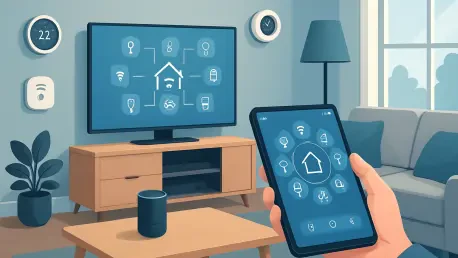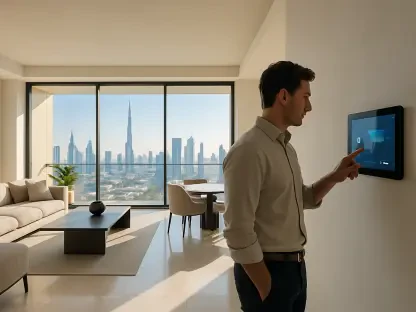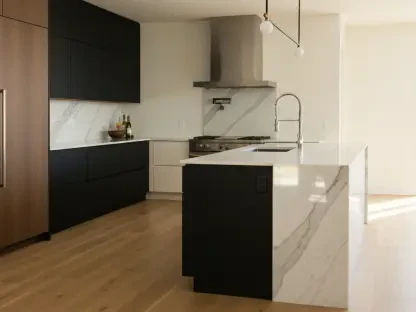Imagine stepping into a home that seems to know exactly what you need before you even ask—lights dimming to create the perfect ambiance for a quiet evening, a robot vacuum silently tackling crumbs from the day, and a security camera alerting you to a package delivery, all managed with a simple voice command or a tap on a smartphone. Smart home technology has evolved into a seamless part of daily life, turning ordinary spaces into hubs of convenience, security, and efficiency. No longer a luxury reserved for tech enthusiasts, these innovations are accessible to everyone, offering solutions that cater to a wide array of lifestyles and budgets. The integration of voice assistants like Amazon Alexa, Google Assistant, and Apple Siri has further simplified control, creating ecosystems where devices communicate effortlessly. With an overwhelming number of gadgets flooding the market, finding the right ones can feel daunting. This guide dives into the standout categories and devices that are shaping living spaces today, focusing on practicality, quality, and transformative potential. From energy-saving lights to multi-functional displays, the emphasis is on how these tools enhance everyday routines while addressing key concerns like privacy and affordability. The journey to a smarter home begins with understanding the options available and how they can be tailored to fit individual needs, ensuring that technology serves as a true extension of personal comfort and style.
Must-Have Smart Home Categories
Smart Speakers and Displays
Central Hubs for Voice Control
Smart speakers have emerged as the cornerstone of any connected home, functioning as both command centers and entertainment sources. These devices allow users to manage an array of gadgets—from lights to thermostats—using simple voice prompts, while also delivering high-quality audio for music, podcasts, or even multi-room sound setups. Products like the Sonos Era 100 stand out for their exceptional sound, featuring punchy bass and crisp highs that appeal to audiophiles. Priced around $249, this speaker also supports integration with various streaming services and can pair with other systems for an immersive home theater experience. Compatibility with major voice assistants ensures it fits into diverse ecosystems, making it a versatile choice for those looking to build or expand their setup. The ability to control an entire household from a single device highlights why smart speakers are often the first step in home automation.
Beyond premium options, budget-friendly alternatives around the $100 mark cater to those just starting out. Devices from major brands like Amazon’s Echo or Google’s Nest Audio provide solid performance with features such as stereo pairing for enhanced sound. The choice often depends on the preferred voice assistant, as each offers unique strengths in terms of device support and service integration. For instance, some speakers excel in bass and mid-range frequencies, making them suitable for casual listening during daily activities. This category demonstrates how accessible smart technology has become, ensuring that even those with modest budgets can enjoy the perks of a connected lifestyle without sacrificing core functionality.
Visual Interfaces for Enhanced Interaction
Smart displays elevate the concept of voice control by adding a visual component, making them ideal for tasks that benefit from a screen. These gadgets, such as the Amazon Echo Show 8 priced at $150, combine the power of voice assistants with capabilities like video calling, streaming content, and displaying useful information like weather updates or recipes. The medium-sized screen strikes a balance for kitchen counters or living room tables, supporting services like Amazon Prime and Netflix, though some platforms require workarounds. Features like face-tracking during video calls add a layer of convenience, ensuring users stay in frame while moving around. Such displays are perfect for households that value multitasking and visual feedback in their daily routines.
Another noteworthy option, the Google Nest Hub (2nd Gen) at $90, caters to those prioritizing privacy with its camera-less design, making it a fitting choice for bedrooms. Its 7-inch screen doubles as a digital photo frame and offers sleep-tracking features alongside streaming capabilities. For users needing a camera, alternatives like the Nest Hub Max provide enhanced audio and gesture controls for video interactions. The decision between different smart displays often hinges on ecosystem preferences and specific needs, such as privacy concerns or integration with existing services like Google Photos. This category showcases how visual interfaces can transform user interaction with smart technology, blending functionality with a more intuitive experience that caters to diverse household dynamics.
Smart Lighting Solutions
Easy Automation for Beginners
Smart lighting serves as an accessible entry point into home automation, offering a straightforward way to experience the benefits of connected technology without a steep learning curve. Devices like the Philips Hue White and Color Ambiance LED Starter Kit, priced around $189, provide a comprehensive solution with bulbs, a hub, and a smart button for manual control. This setup allows adjustments in brightness, color temperature, and even full-color scenes to match any mood or occasion. With compatibility across major platforms like Google, Amazon, and Apple ecosystems through protocols such as Zigbee, these lights ensure reliability for users building extensive setups. The ability to schedule lighting routines—turning on at dusk or off at bedtime—adds a layer of convenience that transforms daily habits with minimal effort.
For those seeking affordability, options like the TP-Link Kasa Smart WiFi Light Bulbs, available for about $27 individually or $40 for a four-pack, deliver full-color control and intuitive app navigation at a fraction of the cost. These bulbs integrate seamlessly with voice assistants and offer features like preset schedules, making them ideal for smaller spaces or gradual upgrades. The simplicity of installation and operation means that even tech novices can enjoy the perks of remote control and automation. Smart lighting not only enhances the aesthetic appeal of a home but also introduces users to the broader potential of a connected environment, often sparking interest in expanding to other categories of smart devices over time.
Balancing Style with Efficiency
Beyond their visual appeal, smart lights play a significant role in promoting energy efficiency, aligning with growing consumer interest in sustainable living. Many devices in this category, including the TP-Link Kasa bulbs, come equipped with usage tracking features through dedicated apps, allowing homeowners to monitor consumption and adjust habits accordingly. This capability can lead to noticeable reductions in energy bills, as lights can be programmed to turn off automatically when not needed or dim during specific hours. The environmental benefit of cutting down on unnecessary power use adds an extra layer of value to these gadgets, making them a practical investment for eco-conscious households looking to minimize their footprint.
Additionally, the versatility of smart lighting extends to its ability to enhance security alongside efficiency, making it a valuable addition to any modern home. Features like vacation mode, where lights simulate occupancy by turning on and off at random intervals, deter potential intruders while users are away. This dual purpose of combining style with functional benefits underscores the appeal of smart lighting in contemporary homes. Whether creating a cozy atmosphere for a family gathering or ensuring a well-lit pathway at night, these devices adapt to a variety of needs while maintaining a focus on reducing waste. The blend of customization and cost-saving potential positions smart lighting as a cornerstone of any energy-savvy, aesthetically pleasing home setup.
Security and Peace of Mind
Surveillance with Smart Cameras
Smart security cameras have become indispensable tools for safeguarding homes, offering real-time monitoring that keeps users connected to their property no matter the distance. Devices like the Blink Outdoor 4, priced at approximately $45, excel in both indoor and outdoor settings with features such as weather resistance, night vision, and motion detection alerts. A battery life that can last up to two years minimizes maintenance, while two-way audio allows direct communication through the camera. Though limited to compatibility with certain voice assistants like Alexa, this camera remains a top choice for those prioritizing versatility and long-term reliability in their security setup. The peace of mind provided by constant vigilance transforms how homeowners approach safety in an increasingly connected world.
The appeal of smart cameras lies not just in their core surveillance capabilities but also in the advanced features that cater to specific concerns. Many models now offer cloud storage options or local recording to ensure footage is accessible when needed, with some requiring subscriptions for full functionality like extended video history. The ability to customize alert zones—focusing on driveways or backyards—reduces false notifications from irrelevant movement, enhancing user experience. These cameras serve as both deterrents and evidence-gathering tools, making them vital for urban and suburban environments alike. As security needs evolve, the adaptability of these devices ensures they remain relevant, providing a robust layer of protection that integrates seamlessly with broader smart home ecosystems.
Front Door Protection with Doorbell Cameras
Smart doorbell cameras add a specialized layer of security by focusing on the critical entry point of a home—the front door. The Arlo Video Doorbell 2K, priced around $92, offers high-resolution footage with a wide 180-degree view, ensuring no detail is missed. Its two-way audio feature enables direct conversation with visitors, while a unique direct video call option connects users to the doorbell instantly when pressed. Compatibility with multiple voice assistants and integration with subscription plans for advanced motion detection—distinguishing between people, packages, and vehicles—elevates its utility. This device is a prime example of how targeted security solutions can enhance safety with precision and convenience.
Beyond basic monitoring, doorbell cameras provide a sense of control and interaction that traditional doorbells lack, making them an essential tool for modern home security. The ability to see and speak to delivery personnel or unexpected guests from anywhere offers a practical solution for busy individuals or frequent travelers. Features like night vision ensure functionality around the clock, while tamper alerts notify users of any interference with the device itself. These gadgets often serve as the first line of defense, integrating with other security systems to create a comprehensive shield against potential threats. The focus on user-friendly design, from easy installation to intuitive app interfaces, ensures that even those new to smart technology can benefit from enhanced front door protection without facing a steep learning curve.
IoT Gear for Everyday Convenience
Hands-Free Cleaning with Robot Vacuums
Robot vacuums have revolutionized household maintenance by taking over one of the most time-consuming chores—cleaning floors. High-end models like the Roomba Combo j9+, priced at $461, combine vacuuming and mopping with advanced features such as obstacle avoidance, even detecting and dodging pet waste with a replacement guarantee for mishaps. Its self-refilling base and precise mapping through app controls allow tailored cleaning routines, making it a top pick for pet owners or those with larger spaces. The automation of such tasks frees up valuable time, allowing focus on more enjoyable or pressing activities while maintaining a tidy home environment.
For those mindful of budget constraints, more affordable options like updated variants of the Roomba 694, available for around $71, still deliver impressive suction and smart navigation. These models may lack some premium features like mopping or advanced obstacle detection, but they handle everyday dirt and debris effectively in smaller homes or apartments. The integration with voice assistants for hands-free operation adds a layer of ease, ensuring that cleaning starts with a simple command. Robot vacuums exemplify how IoT devices can transform mundane responsibilities into effortless processes, catering to a range of needs from comprehensive cleaning solutions to basic upkeep without demanding constant user intervention.
Connectivity Upgrades with Smart Plugs
Smart plugs offer a cost-effective way to bring connectivity to traditional appliances, turning ordinary devices like lamps or fans into part of a smart ecosystem. The TP-Link Kasa Smart Plug Mini, priced at about $37, stands out for its compact design and seamless setup, supporting features like timers and vacation mode to simulate presence when away. Compatibility with major voice assistants and platforms like Apple HomeKit ensures it fits into various setups, providing remote control through intuitive apps. This small but powerful gadget demonstrates how incremental upgrades can significantly enhance daily convenience without requiring major investments or overhauls.
The utility of smart plugs extends beyond simple on-off functionality, offering scheduling options that align with daily routines—such as turning on a coffee maker at a set time each morning. Energy monitoring capabilities in some models provide insights into consumption, helping to identify power-hungry appliances and adjust usage for savings. Their versatility makes them ideal for renters or those hesitant to commit to permanent smart installations, as they can be easily moved or repurposed. By bridging the gap between old and new technology, smart plugs serve as a practical stepping stone into broader automation, proving that even minor additions can yield substantial improvements in control and efficiency within a home.
Reliable Coverage with Wi-Fi Systems
A robust Wi-Fi system is the backbone of any smart home, ensuring that all connected devices operate without interruption across expansive spaces. The TP-Link Deco XE75 Wi-Fi 6 Router System, priced at $250 for a three-pack, offers coverage up to 7,200 square feet, supporting multiple gadgets with stable, high-speed connections. Its user-friendly setup and ability to handle the demands of streaming, gaming, and smart device communication make it a critical component for tech-heavy households. Without reliable internet, even the most advanced gadgets can falter, positioning mesh systems as essential for maintaining a cohesive and responsive smart environment.
The importance of Wi-Fi systems becomes even more apparent as the number of connected devices grows, from security cameras streaming live footage to speakers syncing music across rooms. Advanced features like parental controls and guest networks add layers of customization and security, allowing users to manage access and prioritize bandwidth for critical tasks. The scalability of mesh systems—adding more units to expand coverage—ensures they adapt to changing needs, whether moving to a larger home or incorporating new technology. Investing in a dependable Wi-Fi setup lays the foundation for a frustration-free smart home, where connectivity issues don’t stand in the way of enjoying the full potential of automation and control.
Emerging Directions in Smart Technology
Choosing Your Smart Home Ecosystem
Deciding on a Voice Assistant
Selecting a voice assistant is a pivotal decision that shapes the functionality and compatibility of an entire smart home setup. Amazon Alexa offers extensive device support and deep integration with services like Audible and Prime Video, making it a go-to for those already invested in that ecosystem. Google Assistant shines in handling queries and syncing with tools like Google Calendar, appealing particularly to Android users. Apple Siri, while more limited in third-party device options, provides seamless operation within the Apple ecosystem through HomeKit, catering to fans of that brand. This choice influences everything from speaker selection to the types of gadgets that can be easily integrated, underscoring the need to align with personal tech preferences and existing systems.
The impact of this decision extends to user experience, as each assistant brings distinct interaction styles and capabilities that can significantly influence daily convenience. Some excel in managing complex routines—automating multiple devices with a single command—while others prioritize quick information access or specific app integrations. Evaluating factors like the range of compatible products and the depth of service connections helps narrow down the best fit. For instance, households with diverse gadget brands might lean toward Alexa for its broad reach, while those focused on privacy might prefer Siri’s enclosed system. Making an informed choice at this stage prevents compatibility headaches down the line, ensuring a smoother journey into home automation.
Ensuring Seamless Integration
Compatibility remains a critical factor in building a cohesive smart home, as not all devices work harmoniously across different platforms or protocols. Opting for gadgets that support widely used standards like Zigbee or Wi-Fi can prevent frustrating mismatches, allowing for a unified system where components communicate effectively. Products like Philips Hue lights, which support multiple ecosystems, exemplify the kind of flexibility needed for growing setups. Checking for voice assistant alignment and protocol support before purchasing helps avoid the pitfalls of isolated devices that can’t interact with the rest of the home, fostering a network that operates as a single, efficient unit.
Beyond basic compatibility, integration also involves how well devices enhance each other’s functionality through shared apps or hubs, creating a seamless user experience that maximizes efficiency. Some systems allow centralized control, where a single interface manages lighting, security, and appliances, reducing the need to juggle multiple apps. This streamlined approach saves time and minimizes tech fatigue, especially for users managing extensive setups. Additionally, considering future-proofing—choosing devices with regular firmware updates or expandable features—ensures longevity and adaptability as new technologies emerge. A well-integrated smart home not only performs better in the present but also remains ready to incorporate innovations, maintaining its relevance and utility over time.
Trends Shaping Smart Homes Today
Rise of Multi-Functional Devices
A defining characteristic of current smart home technology is the shift toward multi-functionality, where single devices take on multiple roles to maximize value and efficiency. Smart displays like the Echo Show 8 are prime examples, serving as video call stations, streaming hubs, digital photo frames, and control centers for other gadgets. Priced at $150, such devices reduce the need for separate tools, saving space and simplifying user interaction. This trend reflects a consumer demand for versatility, where the focus is on consolidating capabilities into compact, powerful solutions that address a variety of needs within a single footprint, enhancing both convenience and practicality.
The benefits of multi-functional gadgets extend to cost-effectiveness, as investing in one device with several uses often proves more economical than purchasing individual units for each task. Robot vacuums that also mop, like the Roomba Combo j9+, further illustrate this evolution, combining cleaning methods with smart navigation to tackle diverse floor types. This convergence of purposes caters to modern lifestyles where efficiency is paramount, particularly in smaller living spaces where clutter must be minimized. As manufacturers continue to innovate, the expectation is that multi-functionality will become a standard, pushing the boundaries of what a single gadget can achieve in transforming daily routines.
Emphasis on Sustainability
Sustainability has emerged as a core focus in smart home design, with devices increasingly engineered to reduce energy consumption and support eco-friendly habits. Smart lights and plugs, such as those from TP-Link Kasa, often include features to monitor power usage, providing data through apps that help identify wasteful patterns. The ability to schedule shut-offs or dimming during low-usage periods directly contributes to lower electricity bills and a smaller environmental impact. This alignment with broader societal goals of conservation makes these gadgets appealing to those prioritizing green living alongside technological advancement.
Moreover, the push for sustainability influences product development, with manufacturers incorporating energy-efficient components and promoting longer-lasting designs to reduce electronic waste. Some systems even integrate with renewable energy setups, allowing users to optimize consumption based on solar or other alternative sources. This trend not only benefits the planet but also resonates with cost-conscious consumers seeking long-term savings. The growing availability of such features across price points ensures that sustainable options are not limited to premium products, democratizing access to tools that support both personal budgets and global environmental objectives in the smart home landscape.
Customization for Individual Lifestyles
Personalization stands out as a significant driver in today’s smart home market, allowing users to tailor technology to their unique preferences and routines. Smart lighting systems like Philips Hue enable adjustments in color and brightness to create specific atmospheres, whether for a focused work session or a relaxing evening. Similarly, robot vacuums offer customizable cleaning schedules and zone targeting through apps, ensuring floors are maintained exactly as desired. This level of control transforms generic devices into personalized assistants, adapting to individual schedules and tastes rather than imposing a one-size-fits-all approach.
The depth of customization extends to security and connectivity gadgets as well, with options to set specific alert parameters on cameras or automate appliance usage via smart plugs based on daily habits. This flexibility caters to diverse demographics, from tech-savvy younger users experimenting with dynamic setups to older adults seeking simplified automation for accessibility. The ability to tweak settings through user-friendly interfaces ensures that personalization doesn’t come with complexity, maintaining broad appeal. As smart home technology continues to evolve, the emphasis on tailoring experiences to individual needs reinforces its role as a deeply personal enhancement to living spaces, fostering a sense of ownership and satisfaction in every interaction.
Reflecting on Smart Home Innovations
Looking back, the array of smart home gadgets available today showcased a remarkable blend of innovation and accessibility that redefined living spaces, proving how technology can transform everyday environments. Devices spanning speakers, displays, lighting, security, and IoT gear demonstrated how technology adapted to varied needs, from hands-free cleaning to robust surveillance. The integration of voice assistants as unifying forces stood out, as did the balance between high-end features and budget-conscious options. Trends like multi-functionality, sustainability, and personalization highlighted a maturing market that prioritized user-centric design. Moving forward, the next steps involve assessing personal priorities—whether it’s security, efficiency, or entertainment—and starting with a foundational device like a smart speaker or light to test the waters.









